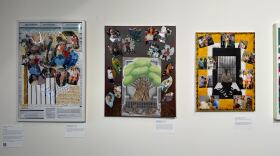A second panel from American artist Jacob Lawrence's sweeping series “Struggle: From the History of the American People" that has been hidden from public view for decades has been located, the Peabody Essex Museum in Massachusetts announced Tuesday.
Officially titled “Immigrants admitted from all countries: 1820 to 1840 — 115,773,” the painting known as panel 28 had not been seen in public since 1960 and was known only through a black-and-white reproduction.
“We are thrilled to share news of this important discovery, especially at a time when Americans are actively engaged with democracy,” Lydia Gordon, the museum's associate curator said in a statement. The Salem, Mass.-based Peabody Essex Museum organized the exhibit.
The painting will now join nearly 30 of the Black artist’s other works painted in the 1950s for the last two stops of a national tour in Seattle and Washington, D.C., museum officials said. The 30-piece series remains incomplete, as the whereabouts of three panels remain a mystery, the museum said.
The 12-inch-by-16-inch panel was found in a New York City apartment, like another painting in the series, panel 16, that was rediscovered in a different home in October. The owner, who wants to remain anonymous, inherited the panel 28 from family, who — like the figures depicted — were immigrants.
The egg tempera on hardboard piece in vivid reds and yellows depicts two women in shawls clutching babies, one of them nursing, as well as a man wearing a wide-brimmed hat and holding a flower pot containing a single red rose, America's national flower. The subjects have oversized hands, symbolizing what it meant to arrive only with what could be carried, the museum said.
It was inspired by a table of immigration statistics published in Richard B. Morris’s Encyclopedia of American History.
“Lawrence created this body of work during the modern civil rights era to interpret pivotal moments in the American Revolution and early decades of the republic as ongoing struggles," Gordon said.
Lawrence, who was born in Atlantic City, N.J., in 1917, was a professor at the University of Washington for 16 years. He died June 9, 2000, in Seattle.
The panel has undergone some restoration work and will join the exhibit “Jacob Lawrence: The American Struggle” on Friday, March 5, at the Seattle Art Museum. The exhibit runs through May 23 in Seattle and then at The Phillips Collection in Washington, D.C., from June 26 until Sept. 19.
It is the first time in more than 60 years the pieces are being shown together.
Museum officials hope that the discovery of panels 28 and 16 leads to the discovery of the three panels that remain missing.
KNKX staff contributed to this report.






